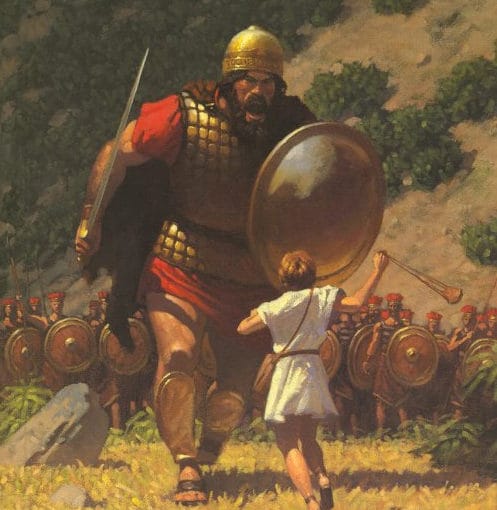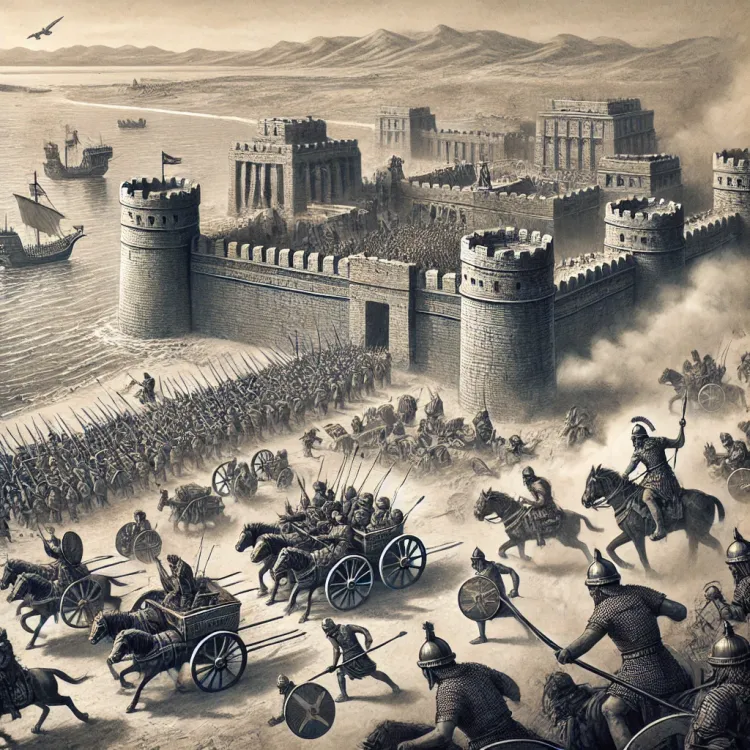The Myth of David, a Man After God’s Own Heart?

The Man, the Myth, the Messiah’s Alleged Granddad
When asked to talk about Old Testament Bible stories, certain names will pop into the minds of even the least religious among us: Adam and Eve, Cain and Abel, Noah, Moses, and, of course, David. Yes, that David—the beloved king who, while still a boy, supposedly dropped a giant in full armor with nothing but a stone and some swagger. The David who was so amazing that God promised his royal line would never fail, and that the future messiah would descend from his house.
But let’s be honest: what we’re doing when we remember David in this light is repeating the greatest hits of a theological PR campaign orchestrated centuries after his death. The fact is, while the figure of David may be entirely mythical, there is enough evidence to suspect he was a real person—just not the person the Bible makes him out to be. Through archaeology, critical scholarship, and a healthy dose of skeptical reading, we can confidently say this: if David existed, his life was nothing like the epic script he stars in.
According to 2 Samuel 21:19, it wasn’t David who killed Goliath—it was Elhanan. The scribes later reassigned the credit.
Archaeology and the Shadow of a King
Archaeologically speaking, there is precious little that can be definitively tied to a historical David. The only widely recognized extra-biblical reference is the Tel Dan Stele, a ninth-century BCE Aramaic inscription that mentions a "House of David" (bytdwd). While this does suggest that a dynastic figure named David may have existed, it doesn’t confirm the grandeur of his supposed reign—only that some later king may have claimed descent from him (Biran and Naveh 1995).
As Israel Finkelstein and Neil Asher Silberman put it, "the glorious epic of David and Solomon... is a brilliant product of the human imagination" (Finkelstein and Silberman 2001, p. 142). Their archaeological research paints a picture of the early Iron Age highlands as a landscape dotted with small, struggling villages—not a backdrop fit for a sprawling, opulent empire.
A Chieftain, Not a King
According to biblical chronology, David would have lived around 1000 BCE. But this wasn’t the era of grand kingdoms and powerful thrones. Archaeological surveys of the Judahite hill country at the time reveal a sparse, rural population—estimated at around 20,000 people—living in small, scattered villages with no signs of centralized government or state-level organization (Finkelstein and Silberman 2001, pp. 101–103).
If David ruled anything, it was likely a modest hill-country chiefdom with sandals, slingshots, and sheep. A lot of sheep. Not quite the gleaming kingdom of marble palaces and gold-lined sanctuaries that the Bible describes. Think less Game of Thrones, more Lord of the Flies—with sheep.
Before the Torah, Before the Temple
Here’s something most churchgoers never learn in Sunday school: David’s story, if rooted in history at all, takes place centuries before the Torah, the Temple, or even the concept of Mosaic Law. He wasn’t breaking commandments—because the commandments didn’t exist yet.
The Book of Deuteronomy and the sweeping reforms under King Josiah happened in the late seventh century BCE—long after David’s time. The First Temple wouldn’t be built until the Solomon narrative kicks off (and even that is debated), and the codification of Jewish law didn’t occur until the post-exilic period. So when the scribes came to write and edit the David stories, they were retrofitting a tribal warlord into a theological frame that hadn’t existed during his lifetime.
From Warlord to Worship Leader
So how do you reconcile a national hero who was also a violent, manipulative, adulterous warlord? Easy—you rewrite him. The scribes and redactors who preserved David’s legend were faced with a problem: he was a blood-soaked military leader whose family was a walking soap opera of betrayal, rape, and fratricide. But he had also become a foundational symbol of Israelite identity. Like a sacred cow wearing chainmail, he couldn’t just be thrown out.
Instead, they leaned into a narrative of repentance and divine favor. David’s sins—especially the nastier ones—were reframed with moral lessons. He was no longer just guilty. He was remorseful. He wasn’t a liability to monotheism—he was a tragic role model. He was flawed, sure, but aren’t we all?
The Blood on His Hands: David, Bathsheba, and Poor, Poor Uriah
One of the Bible’s most chilling stories is David’s pursuit of Bathsheba, wife of Uriah the Hittite. While Uriah was off fighting David’s war, David was fighting a very different kind of battle back home—and he lost. In short, Bathsheba got pregnant. And since the man who was supposed to impregnate her was unavailable for the task, David needed a cover-up. He recalled Uriah from the front lines, hoping he’d sleep with his wife and unknowingly claim the child as his own. But in a show of loyalty that must’ve made David sweat, Uriah refused, choosing instead to honor his fellow soldiers by forgoing his matrimonial pleasures in a noble sign of solidarity to his brothers in arms who didn't have the same opportunity.
So David did what any God-favored man would do: he gave Uriah a sealed message for his commanding officer that had him order Uriah into the most dangerous part of the battle on the front lines. Poor Uriah was not only cuckolded by David, but he was tricked into carrying his own death warrant to seal his eventual doom. Uriah died as David planned, and David’s hands stayed clean—but only in the literal sense (2 Samuel 11, NRSVue).
This wasn’t just adultery. It was devious, calculated, cold-blooded murder by proxy. And yet David suffered no earthly consequences. His child with Bathsheba died—a divine punishment—but David himself remained king, sang a few psalms, and carried on.
Goliath’s Slayer… Or Someone Else’s Victory?
Perhaps David’s most iconic story is his duel with Goliath—a tale known even to people who’ve never cracked a Bible. The scene is unforgettable: the young shepherd faces a towering warrior, delivers a killer one-liner, then drops the giant with a stone before decapitating him with his own sword.
Or did he?
In 2 Samuel 21:19, we’re told that it was Elhanan—not David—who killed Goliath. Later redactors clearly found this awkward. Here they had this amazing act of bravery and heroism performed by a virtual nobody on the one hand, and a perfectly serviceable, nationally adored hero with no heroic acts on the other. So they did what any self-respecting P.R. firm would do. They rewrote the tale. David got the glory, Elhanan got a footnote, and the national hero got a backdated battle trophy.
As Finkelstein and Silberman explain, "It is not unusual in ancient literature for the deeds of a heroic figure to be attributed to the founder of a dynasty or a legendary national hero. What was originally a local tale could be elevated to national myth by associating it with a widely recognized and beloved name" (Finkelstein and Silberman 2001, p. 135).
Exile, Edit, Exaltation
Much of the biblical text about David was written or revised during or after the Babylonian exile in the 6th century BCE—a time of national trauma, identity crisis, and theological reflection. They were God’s chosen people, after all, and they had spent centuries being manhandled by larger and more powerful neighbors, struggling just to maintain their identity. When Babylon came to call and conquered Judah, destroyed the temple, and carried off the Judahite elites into exile, it was enough to make people doubt. In that context, David became more than a man. He became a symbol: not just a king, but a promise.
And like any good symbol, he needed a makeover. The exile’s scribes smoothed out his rough edges and painted him as a flawed but faithful servant of God. Less warlord, more worship leader. Less scandal, more psalms. But beneath the theological whitewash, the real David—whoever he was—still lingers like bloodstains beneath fresh paint.
Works Cited
Biran, Avraham, and Joseph Naveh. "The Tel Dan Inscription: A New Fragment." Israel Exploration Journal, vol. 45, no. 1, 1995, pp. 1–18.
Finkelstein, Israel, and Neil Asher Silberman. The Bible Unearthed: Archaeology's New Vision of Ancient Israel and the Origin of Its Sacred Texts. Free Press, 2001.
The New Revised Standard Version Updated Edition Bible. National Council of Churches,





Comments ()